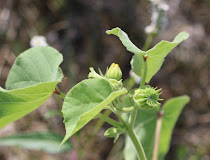They are the overlooked. The ignored, the downtrodden and the unwanted. In the wrong place at the wrong time (is there ever a right place and a right time?). When they do gain attention, it is usually an exasperated sigh at the "overgrown weeds" or a judgmental shake of the head at an unkempt lawn.
But really. Look at them out there, in the blazing sun, growing out of parched, poor-quality soil. Sometimes sprouting from cracks in the sidewalk. No need for semi-daily waterings, fertilizings, herbicidings, insecticidings, and other babying. Not for these rugged individualists! Give them a week or two to get started, and they're off and running: growing, flowering, and setting seed before you can gas up the lawnmower.
Many are non-natives, introduced as forage or for erosion control, or stowed away among some less assertive plant materials. Some are natives, able to hold their own in the harsh environment of weedy lots, urban sidewalks, and points in between. Some may pass judgment on the "invasives", with good reason. But many of them grow where other plants fear to tread, and can act as pioneers on a hostile landscape.
When you are walking around sunny neighborhoods and yards that haven't been coddled, take a moment to notice these subtle, scrappy survivors.
Prickly Lettuce (Lactuca serriola), a non-native. Clouds of small, light-yellow flowers float on branching stems several feet tall. The leaves have a line of fierce-looking spikes on the underside.
Horseweed (Conyza canadensis) is a tall native topped with a plume of uninspiring flowers. The narrow leaves arranged around the stem can look a bit like the more flamboyant Liatris, but the inflorescence at the top is very different.
Alfalfa (Medicago sativa), one of those plants introduced as forage that has proved to be highly successful once it escapes the confines of cultivation. It avoids the bad reputation of some of its fellow non-natives by keeping to the poorer-quality areas and not usually crowding out desirable native plants.
Another low-growing native plant with subtle flowers is Prostrate Vervain (Verbena bracteata). Its inflorescence is a spike up to 6" long, with bracts the length of the spike and tiny purple flowers near the tip.






No comments:
Post a Comment